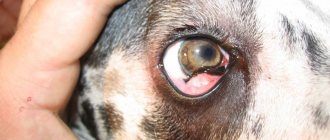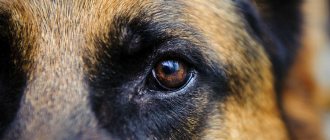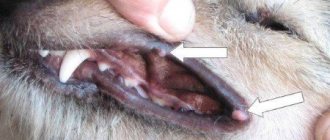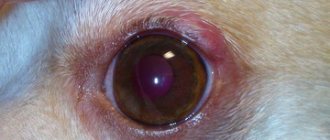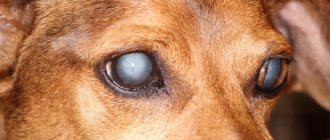Main causes of eye inflammation
Let's look at the typical causes of eye inflammation that veterinarians most often encounter in their daily work:
- Eye contact with dust, sand, and other debris. For this reason, you should not walk your dog when it is hot outside and there is a strong wind blowing. Grass stubble is especially dangerous, since its surface often contains spores of pathogenic fungi. The latter cause severe forms of inflammatory reactions that are difficult to treat. Hard spines and hairs severely injure the surface of the cornea, which rarely goes away without leaving a trace.
- Consequence of poisonous insect bites. Midges are not poisonous, but from their bites, not only the dog’s eyes, but also most of his body can become swollen.
- Dry indoor air. In such conditions, the lacrimal glands may not cope with their function, causing the conjunctival cavity to dry out, become irritated and swollen. In addition, the surface of the organ, no longer protected by a film of tear fluid, becomes extremely susceptible to the action of pathogenic and conditionally pathogenic microflora, which also provokes the development of the inflammatory process.
- Inflammation of the eyes due to frostbite. At extremely low temperatures, frostbite of the conjunctiva and cornea is a more than likely outcome. The ambient temperature in this case should not be higher than -45°C, or even more extreme.
- The dog's own fur. Getting on the cornea and conjunctiva, it severely scratches the surface of the organ, which opens the gates for infection. Pathogenic microflora that enters the conjunctival cavity at this time will easily cause an inflammatory process.
Causes
There are several causes of swelling in the eye area. It may indicate internal problems in the body or be caused by external factors. Often, swelling may be accompanied by symptoms such as:
- The presence of a tumor accompanied by purulent discharge indicates conjunctivitis. The cause of the disease may be an infection in the eye. Also, the development of conjunctivitis is observed against the background of a cold;
- A tumor of the eyelid above the eye is a stye. Its development is possible as a result of debris entering the eye, which provokes inflammation of the meibomian gland;
- Increased lacrimation due to a tumor is an allergic reaction. An allergy can be triggered by a new product in an animal’s diet, a foreign object getting into the eye, an insect bite, etc.;
- One eye of a dog with inflammation of the cornea is swollen - keratitis. The cause may be worms, infection and eye injury;
- Against the background of the tumor, a fear of light developed - blepharitis. The dog becomes like a person who has been severely stung by bees. The eyes become like small slits; the animal cannot even open them. The dog tries to find a secluded place, covering its eyes with its paws;
- Not only the eye is swollen, but also part of the muzzle - anaphylactic shock caused by a severe allergic reaction. An increase in symptoms is observed, and if appropriate treatment is not started, this can cause death. The cause of this reaction may be soft tissue injuries, for example, after a fight between two dogs. Swelling after such an injury can cause hematomas;
- Swelling of the eyes that occurs periodically - kidney or heart disease. If swelling appears in the morning and then goes away, this indicates that the animal has problems with internal organs.
In this case, it is not possible to independently diagnose a particular disease in your pet. Therefore, when the first symptoms of a problem appear, you must immediately go to the veterinarian, as some swelling develops quite quickly.
Diseases accompanied by eye inflammation
Some diseases accompanied by eye inflammation are relatively harmless, while other pathologies require urgent intervention from a veterinarian:
- Allergy.
- Conjunctivitis of various origins. Their cause may be bacterial, viral or fungal microflora, trauma, the same allergic reactions, natural predisposition and dozens of other factors (including an overly sensitive nervous system).
- Diseases of inflammatory origin. A dog's eye may become swollen due to the development of stye. In this case, only one eye swells, and blepharitis manifests itself in the same way (i.e., inflammation of the eyelids themselves).
- Turning of the eyelids. With this disease, the edge of the eyelids (with eyelashes and hair) turns under and comes into direct contact with the cornea. All this instantly leads to the development of inflammation and, accordingly, severe swelling.
- Parasites. In many cases, the underlying cause is thelaziosis. With this disease, the eyes are parasitized by the larvae of one unpleasant species of flies. Their activity leads to the development of inflammatory processes and, accordingly, swelling.
- Consequence of pathologies of the kidneys and/or heart . This is indicated by the location of the edema: they develop not only in the eyes and face, but also in the area of the chest, groin, abdomen and limbs.
- Tumors. At the same time, their origin (benign or malignant) does not matter much, but malignant swellings grow much faster, and therefore the swelling progresses within a few weeks at most.
If only one eye of a dog is swollen, what does this mean?
A symptom in which only one eye of a dog is swollen may indicate the following:
- The eye was damaged by something. This can be guessed by the appearance of the organ, by the presence of dried blood, exudate, abrasions on the face, etc.
- Infectious lesions of only one eye , but, if this is true, after some time the disease will spread to the second organ. As a rule, the disease does not take much time to transfer and the dog’s eye inflammation becomes bilateral.
- Tumor lesions of the eye , or (but the likelihood of this is extremely low) parasitic infestation of only this organ.
In most cases, swelling of only one eye means that the infection has not yet reached the second organ. But if the dog is not provided with qualified assistance, this will happen very soon.
The dog's eyelid is swollen photo
Conjunctivitis
This disease is manifested by inflammation of the mucous membrane of the eye. As a rule, conjunctivitis is bacterial in nature. The pathology is accompanied by severe redness of the eyes, profuse lacrimation, and sticking of the eyelids. In severe bacterial infections, purulent exudate oozes from the eyes, irritating the eyelids and causing them to swell.
For conjunctivitis, treatment is carried out using antiseptic and antibacterial drops. The treatment regimen is selected by the doctor, depending on the dog’s age and general health, since conjunctivitis in animals can be a secondary symptom of serious diseases.
Blepharitis
If your dog's lower eyelid is swollen, blepharitis should be ruled out. This pathology is characterized by inflammation and severe swelling of the eyelid, both lower and upper. Blepharitis most often acts as a complication of other diseases. It can be bacterial, viral, fungal or allergic in nature. Often inflammation develops due to eyelid injuries and infection entering the wound.
Blepharitis is dangerous due to the spread of inflammation to the conjunctiva and cornea.
Characteristic signs: swelling of the eyelids, redness of the entire eye, small pustular rash. With blepharitis, severe itching occurs, so the dog may scratch the skin until wounds and crusts form.
Treatment: warm soothing compresses on the eye, antiseptic treatment, antibacterial drops.
Associated symptoms and their causes
Many of the additional symptoms are not very bright, but you definitely need to pay attention to them, as they can directly indicate the cause of the disease.
Eyes fester
Suppuration of the eyes may indicate:
- Conjunctivitis.
- Turning of the eyelids.
- Eye injury with subsequent contamination of the organ with pyogenic microflora.
- Disintegration of a malignant tumor.
In all these cases, pyogenic microflora gets into the eyes.
Swelling of the nose, lips, ears, or entire face
If the dog, in addition to suppuration of the eyes (eyes), has a swollen nose, lips, ears or entire face, then this may indicate either an allergy (which is most likely), or edema of cardiac origin.
- The same symptoms can develop with many types of renal pathologies. In all these cases, swelling develops.
- In case of allergies, it develops due to increased vascular permeability, while in case of cardiac pathologies, edema is a consequence of insufficient blood circulation, which is why its liquid part can leak into the tissues.
- Swelling of a renal nature is associated with the inability to quickly remove excess fluid from the body.
Redness of the eyes
In itself, redness of the eyes is not considered to be any significant symptom, since it is characteristic of almost all ophthalmological pathologies.
Redness in all these cases is a sign of inflammation. The red color is due to a rush of blood to the site of pathology (the phenomenon is called hyperemia).
My eyes are watering
In cases where a dog's eyes are watery and swollen, the following reasons can be suspected:
- Getting into the conjunctival cavity of caustic, irritating substances (tobacco smoke, household chemicals, etc.).
- Foreign bodies.
- Parasites.
- Turning of the eyelids.
In all these cases, increased secretion of tear fluid is needed to quickly flush out irritants from the conjunctival cavity. Of course, in the case of entropion of the eyelids or similar pathologies, this helps little.
Eyes itch and itch
This may indicate an allergy, the presence of parasites or foreign bodies in the conjunctival cavity. In these situations, itching (as well as swelling) is a sure sign of the release of histamine and histamine-like substances into the animal’s blood.
Hair coming out around the eyes
If hair comes out around the pet’s eyes, and this process is accompanied by swelling and inflammation, then this symptom also does not indicate anything specific.
The fact is that the fur comes out under the influence of exudate, tear fluid; its loss may be due to the constant combing of these places by the animal itself. Those. baldness of the skin around the eyeballs is a symptom characteristic of many ophthalmological pathologies.
The eye is cloudy
If clouding of the eye is accompanied by watery eyes, we can almost certainly talk about corneal injuries or even glaucoma (especially if the dog is already old). This symptom is caused by a decrease in the permeability of the cornea to light.
If such a sign appears, the pet should be immediately shown to a veterinarian, since otherwise the animal will almost certainly not only become partially blind, but may also lose the affected eye.
When to contact a veterinarian
When your Yorkie's eyes are running, the first thing to do after providing first aid is to contact a veterinarian. You cannot help your pet on your own ; advanced pathology threatens severe complications and loss of vision.
You need to act immediately if:
- symptoms last longer than 3 days;
- mucous membranes turn red;
- the eyelids are swollen;
- lymphatic follicles are swollen;
- the secreted secretion smells unpleasant;
- a purulent, whitish or brown substance flows;
- fever, chills, vomiting, indigestion are observed;
- The terrier is apathetic, does not want to eat, behaves restlessly, and rubs the affected area with its paws.
The veterinarian will take a smear for diagnostic analysis, and based on the results of the study, will prescribe drops, antibiotics or antihistamines, and set the dosage and course of use.
Yorkies often have watery eyes, which is due to improper care, maintenance and feeding. The main thing is to show the dog to a veterinarian in a timely manner to prevent complications. Prevention consists of observing sanitary and hygienic standards and careful handling of the animal.
SIMILAR ARTICLES
WHAT TO FEED A YORKSHIRE TERRIER PUPPY
When getting a Yorkshire Terrier puppy, it is first of all important to find out what to feed him. This is a small dog with...
YORKSHIRE TERRIER: HISTORY OF THE BREED, ORIGIN, FAMOUS YORKIES
Every day, charming dogs with luxurious fur are becoming more and more popular, their aristocratic appearance creates...
YORKSHIRE TERRIER - DESCRIPTION AND CHARACTER OF THE BREED
More and more people are choosing Yorkshire Terriers as pets. But what did this breed deserve...
BED FOR A YORKSHIRE TERRIER: HOW TO CHOOSE
The Yorkshire Terrier should have a private place where he can retire. It should only belong...
HOW TO CUT YOUR YORKSHIRE TERRIER
There are many types of Yorkie haircuts. In this article we will figure out which haircuts are suitable for Yorkies...
HOW TO TRAIN A YORKSHIRE TERRIER TO NAPPY
Diaper training a Yorkshire Terrier is very helpful for people with busy daily routines, so as not to...
WHAT TO DO IF YOUR YORKIE'S EYES ARE TEARING
What to do if your Yorkie's eyes are watery: Causes and prevention
YORKSHIRE TERRIER: DESCRIPTION OF THE BREED, STANDARDS, HOW LONG DO YORKIES LIVE
Yorkshire Terrier: description of the breed according to the standard, character and developmental characteristics of dogs, life expectancy, advantages and...
HOW TO WASH YOUR YORKSHIRE TERRIER CORRECTLY
It’s worth learning how to wash a Yorkie because the condition of your pet’s coat depends on it. For Yorkie...
HEAT OF A YORKSHIRE TERRIER
The Yorkshire Terrier's heat will mark the pet's readiness to breed. It’s not just for the dog,…
NICKNAMES FOR YORKSHIRE BOYS AND GIRLS - WHAT TO NAME A YORKSHIRE TERRIER
Popular nicknames for Yorkie boys and girls by temperament, origin, pedigree, color, what are the names of Yorkies...
The main factors that provoke eye inflammation
Some factors that provoke eye inflammation require more detailed consideration.
Swelling after vaccination
If your dog develops (even mild) eye swelling after vaccination, you should immediately inform your veterinarian. The fact is that this indicates an allergic reaction.
In the case of vaccines, this sign may indicate anaphylactic shock or Quincke's edema. If the process is not stopped immediately, the animal may die.
From a blow or injury
Swelling from a blow or bruise should not be a cause for concern. Swelling in this case is of traumatic origin, i.e. fluid enters the intercellular space due to the destruction of cells and tissues (due to impact or other mechanical impact).
Allergy
Allergies are one of the most common, leading causes of swelling and inflammation of the eyes. The root cause of swelling is the release of histamine. This substance sharply increases the porosity (permeability) of blood vessels, as a result of which the liquid fraction of blood enters the tissues. The danger of an allergy is that it can easily “mutate” into anaphylaxis or angioedema, as a result of which the animal will die.
After the walk
If your eyes are swollen after a walk, this indicates either debris or insect bites. In the first case, the swelling is caused by the onset of inflammation, in the second - by an allergic reaction to the bite.
After a bee or wasp sting
The causes of eye swelling after a bee or wasp sting is an allergic reaction. Considering that bites in the muzzle area are extremely dangerous (causing anaphylaxis, for example), the animal in this case needs to be urgently shown to a veterinarian.
Dirt got in
Most likely, the swelling is a consequence of inflammation. If possible, if dirt gets into your eyes, you should rinse your eyes as soon as possible.
First aid at home
In case of swollen eyes, timely and high-quality first aid at home can significantly simplify further treatment. The owner himself can do the following:
- In the first hours after swelling, you can apply a cold compress for 15-20 minutes; the procedure can be repeated for the first day every three or four hours.
- Crusts of dried exudate, blood, etc. removed using a cotton pad and sterile saline solution.
- If there is a suspicion of an allergic origin of the edema, the dog is given a diphenhydramine tablet.
- In many cases, veterinarians recommend rinsing the eyes.
- It will not hurt to put 1% tetracycline ointment into the conjunctival cavity.
If the animal's condition gives rise to any concern, it should be immediately shown to a veterinarian!
Treatment
Experienced breeders know what to do in such situations. Beginners still have to master the technique of providing first aid to their pet. Basic therapy takes into account the cause of swelling.
But there are also general rules that are worth taking into account:
- the dog should not be allowed to put its paws in its eyes - for this purpose a special collar is put on the animal;
swollen, watery eyes should be washed with cooled boiled water;- A compress helps reduce swelling: tie a plastic bottle or heating pad filled with cold water to the dog’s eye;
- Provide your pet with plenty of fluids.
If there is a suspicion of an allergy, the dog’s diet is reduced to a minimum. In all cases, treatment of swelling should be comprehensive, when medications are combined with traditional medicine.
Medications
Medicines will be needed when swelling is caused by an allergic reaction. Antihistamines can also be used in the form of drops. But before putting drops in your dog’s eyes, the product must be diluted with water.
Inflamed conjunctiva is treated not only with Levomycetin; other antibiotics (Kanamitsit or Erythromycin) can also be used. Ophthalmic ointments and drops help well.
To alleviate the animal’s condition, it is recommended to apply Tetracycline ointment behind the eyelids and distribute it over the eye membrane. The procedure is carried out at least 5 times a day until the swelling subsides.
You can also instill a solution of Novocaine (2%) or Lidocaine into your eyes. But using local anesthetic for more than 5 days is not recommended.
If your dog has a dry, hot nose, you will need an antipyretic (Carprofen, Vedaprofen). It is given once a day, administered orally. The dosage is calculated taking into account the pet’s body weight.
Traditional medicine
At home, folk recipes are used to treat conjunctivitis.
The animal's eyes are washed several times a day:
furatsilin solution;- herbal decoctions (chamomile, rosemary, calendula);
- special lotion.
First, the procedure uses a clean soft cloth to remove all dirt from the muzzle, then moisten a cotton pad with warm water and gently wipe the dog’s eyes, moving from the outer corner to the inner.
In what cases should you contact the clinic?
We have already repeatedly indicated that a dog with swollen eyes should in any case be shown to a specialist. But in some cases you need to do this as quickly as possible:
- If you suspect snake bites.
- Any allergic reaction accompanied by swelling of the eyes and muzzle. If a dog's eye swelling is accompanied by strange wheezing, hissing, or other changes in breathing, you need to drop everything and take him to the doctor as quickly as possible, since these signs indicate swelling in the upper respiratory tract, or even in the lungs themselves!
- In case of any strong pain reaction, when the dog squeals, rolls on the ground, and constantly tries to scratch his eyes with his paws. This often happens after bee and hornet stings.
- In cases of severe suppuration, consultation with a veterinarian is also necessary.
Non-infectious causes
The most common non-infectious causes of eye swelling in pets are:
- Allergy.
- Entry of a foreign object.
- Insect bites.
An allergic reaction can be caused by anything from food to irritation from slimy dust or pollen. It is quite simple to figure out that it is due to allergies that a dog’s eye is swollen, since symptoms appear a short time after contact with the allergen.
If your dog eats a new treat, and an hour later he scratches his swollen eye, the reason is precisely intolerance to the product. As a rule, with allergies there is also redness of the conjunctiva, severe itching, and tearing.
Here's what an owner can do to alleviate the pet's condition:
- break contact with the irritant;
- rinse the eye with water;
- apply a cool compress;
- give your pet an antihistamine;
- Apply antihistamine drops to the eye.
There are several ways to interrupt contact with the irritant. If we are talking about food, you should simply replace the diet with a hypoallergenic one. If swelling of the eyelids is caused by dust, household chemicals, or animal detergents, the eyes should be thoroughly rinsed with clean water.
To quickly relieve symptoms, you should give your pet an allergy pill. This can be any “human” drug - Diazolin, Suprastin, Allerzin. Dosage – no more than a quarter of a tablet. Small dogs are given half this dose.
Swelling of the eye may be due to a foreign object. It could be a piece of wood, metal shavings, or a small pebble. If an object scratches the eyelid and remains in the wound, severe swelling may develop. In this case, the owner must:
- Carefully examine the eyelids.
- Rinse eyes with water.
- Retrieve a foreign object.
- Apply any antiseptic drops.
Curious dogs often chase wasps and bees. Insects do not always share the dog's interest, so bites on the lower or upper eyelid are common. When bitten, swelling increases rapidly, literally in a few minutes. In this case, the owner should:
- apply a cold compress;
- remove the sting if bitten by a bee;
- Give the dog an antihistamine tablet.
As you can see, the non-infectious causes of edema are quite obvious and it will not be difficult for an attentive person to determine the causes of eye swelling in a pet.
How to properly wash your dog's eyes
For many ophthalmological pathologies, it is recommended to wash the eyes.
Tools and instructions:
- First you need to buy a small syringe (up to 5 ml) or the smallest syringe with a long spout.
- As a washing liquid, you can use either a sterile saline solution, or a 1% solution of hydrogen peroxide, or a very weak solution of potassium permanganate, or furatsilin. The latter is the most preferred option.
- Cotton pads or plain cotton wool will also come in handy.
The washing itself is extremely simple. It is necessary to open the animal’s eyelids with the fingers of your left hand, and with the help of your right hand, smoothly squeeze out the contents of the syringe or syringe into the upper right corner of the eye. This way, the maximum amount of dirt is washed away. The procedure can be repeated every hour, but usually it is enough to do this up to 4 times a day.
Prevention and care for your pet's eyes
Caring for your dog’s eyes and timely preventive measures will help avoid many of the problems that we wrote about above:
- In the case of long-haired and shaggy dogs, it is necessary to trim off excess hair around the eyes in a timely manner. This will prevent hair from entering the conjunctival cavity.
- The eyes should be examined at least once a day; if dirt, crusts and other debris are found, it should be removed using cotton pads and sterile saline solution.
- The animal must be vaccinated in a timely manner and taken to the veterinarian for a preventive examination at least once a quarter.
- If the area is unfavorable for thelaziosis, the dog should be regularly treated with repellents (during the warm season).
